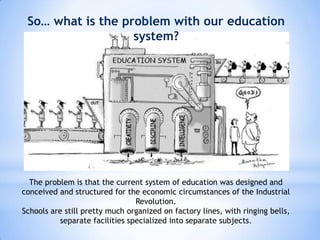Breaking education paradigms
- 1. Presented by: Jaime Bonilla Cambridge International Examinations Coordinator Colegio Inglés de los Andes Santiago de Cali, May 3rd 2013 BREAKING EDUCATION PARADIGMS
- 2. *
- 3. The first one is economic!
- 4. The second one is cultural!
- 5. So… what is the problem with our education system? The problem is that the current system of education was designed and conceived and structured for the economic circumstances of the Industrial Revolution. Schools are still pretty much organized on factory lines, with ringing bells, separate facilities specialized into separate subjects.
- 6. Also, the fact that we are trying to meet the future by doing what we did in the past doesn’t help!
- 7. I don’t think so. We put them through the system by age group under the assumption that the most important thing kids have in common is how old they are. Does educating children based on age groups work?
- 8. What has changed in the past 20 years? Our children are living in the most intensely stimulating period in the history of the earth. They are bombarded with information from every platform, computers, from iPhones, from advertising holdings from hundreds of television channels. And we are penalizing them for getting distracted…From what? Boring stuff. At school for the most part!
- 9. Is standardized testing the best way to assure fairness ? No…There are kids who are much better than other kids at the same age in different disciplines, at different times of the day or better in smaller groups than in large groups or sometimes they want to be on their own.
- 10. What is divergent thinking? Divergent thinking isn't the same thing as creativity. It's the ability to see lots of possible answers to a question. Lots of possible ways of interpreting a question.
- 11. How many uses can you think of for a paper clip? Most people might come with 10 or 15. People who are good at this might come with 200. And they do that by saying. Well, could the paper clip be 200 foot tall and be made of foam rubber?
- 12. Is copying from another cheating? Well, outside school that's called collaboration but, inside schools it’s called cheating. And this isn't because teachers wanted this way it's just because it happens that way. We have to recognize most great learning happens in groups. That collaboration is the stuff of growth.
- 13. The major issue with our education paradigms as we know it today is that it was created for a different time. We need to get with the times and understand that these new generations have different needs. We all have a capacity when we are young to think divergently and we are being taught out of this as we go through the current paradigm. We need to place emphasis on allowing our children to be fully awake and use all sides of their creative-intellectual selves to create adults that are ready to face our changing world. In summary…
- 14. Thank you for your kind attention! jbonilla158@inglesdelosandes.edu.co www.tesol5.blogspot.com QUESTIONS???














